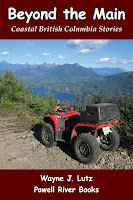Coastal BC Plants: Evergreens
Evergreens
Evergreens are plants that maintain their leaves (or needles) throughout the year in all seasons. In essence, they are ever green.
Evergreens come in many sizes and shapes, from shrubs to trees.
 Salal is an evergreen shrub that's ubiquitous in Coastal BC forests. They grow in the shade of towering evergreens, and in open areas along cliffs and log slashes. The purple berries provide food for bears, birds, and people who eat them fresh (they can be bland), in jams and wine.
Salal is an evergreen shrub that's ubiquitous in Coastal BC forests. They grow in the shade of towering evergreens, and in open areas along cliffs and log slashes. The purple berries provide food for bears, birds, and people who eat them fresh (they can be bland), in jams and wine. Arbutus is an example of a broad-leafed evergreen tree. The tall trunks reach for the sun with branches at the top with egg shaped leaves. The trunks have smooth chartreuse green bark that turns a distinctive reddish-brown later in the season before peeling. Arbutus grow on bluffs along the Pacific Northwest coast up through British Columbia. They are a common site on the lower portion of Powell Lake
Arbutus is an example of a broad-leafed evergreen tree. The tall trunks reach for the sun with branches at the top with egg shaped leaves. The trunks have smooth chartreuse green bark that turns a distinctive reddish-brown later in the season before peeling. Arbutus grow on bluffs along the Pacific Northwest coast up through British Columbia. They are a common site on the lower portion of Powell Lake  Cedar trees grow throughout the Coastal BC forests. At lower elevations the Redcedar grows in moist areas with rich soil. It was a vital resource for First Nations peoples because it was used shelters, dugout canoes, totem poles, tools, arrows, masks, paddles, and medicinal purposes. The bark became clothing, rope, and baskets. At higher elevations the Yellow Cedar grows. Cedar wood is valuable because of its quality and resistance to decay.
Cedar trees grow throughout the Coastal BC forests. At lower elevations the Redcedar grows in moist areas with rich soil. It was a vital resource for First Nations peoples because it was used shelters, dugout canoes, totem poles, tools, arrows, masks, paddles, and medicinal purposes. The bark became clothing, rope, and baskets. At higher elevations the Yellow Cedar grows. Cedar wood is valuable because of its quality and resistance to decay. Firs are one of the most common trees in the forests around Powell River. They grew here naturally, and are now a favourite commercial tree planted during reforestation by timber companies. The trees grow tall and straight up to 80 metres (260 feet). Old growth trees can achieve a girth of 3 metres (10 feet) at one hundred years. On the cliffs near our cabin the trees are approximately 100 years old, but most of the cut blocks are much younger.
Firs are one of the most common trees in the forests around Powell River. They grew here naturally, and are now a favourite commercial tree planted during reforestation by timber companies. The trees grow tall and straight up to 80 metres (260 feet). Old growth trees can achieve a girth of 3 metres (10 feet) at one hundred years. On the cliffs near our cabin the trees are approximately 100 years old, but most of the cut blocks are much younger. Pine is a less common tree in the Powell River backcountry. There are a variety of species in the Pine family that grow in Coastal BC. The Western White Pine is found at lower elevations on the mainland and Vancouver Island. Lodgepole Pines can be found at the higher elevations.
Pine is a less common tree in the Powell River backcountry. There are a variety of species in the Pine family that grow in Coastal BC. The Western White Pine is found at lower elevations on the mainland and Vancouver Island. Lodgepole Pines can be found at the higher elevations.  Hemlock is another commercially harvested evergreen that grows in the Powell River area. The Western Hemlock grows both naturally and is planted during reforestation. The wood grain is straight and it's commonly used today in architectural millwork. First Nations peoples carved the wood for bowls and implements.
Hemlock is another commercially harvested evergreen that grows in the Powell River area. The Western Hemlock grows both naturally and is planted during reforestation. The wood grain is straight and it's commonly used today in architectural millwork. First Nations peoples carved the wood for bowls and implements.Evergreens make our home up the lake beautiful in all seasons. -- Margy




















Great info on the Arbutus. I had no idea it was an evergreen tree. Love the color of its bark.
ReplyDeleteThey do go through cycles with bark sloughing of, and berry production, but their leaves stay all year long. - Margy
DeleteWonderful information on our evergreens - thanks.
ReplyDeleteI love the arbutus. Are they slow or fast growing?
ReplyDeleteThey seem to be fairly slow growing, One site said about 300 mm (12 inches) or so per year. - Margy
DeleteBeautiful evergreens! I can almost smell the aroma of their needles!
ReplyDeleteGreat choice for E. I didn't know about the first bush - lots to learn. In 2008 we travelled around Vancouver Island and saw the ancient forest - we were awed!
ReplyDeleteSalal covers our forest floors. People go out to pick the leaves to sell to floral companies to use in arrangements because they last so long after cutting. - Margy
DeleteHow wonderful your life is, living on the lakes and rivers. Thanks for sharing your surroundings with us.
ReplyDeleteWil, ABCW Team.
awesome
ReplyDeleteROG, ABCW